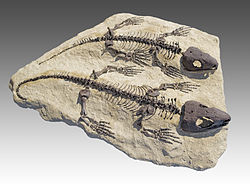カプトリヌス
表示
| カプトリヌス | |||||||||||||||||||||
|---|---|---|---|---|---|---|---|---|---|---|---|---|---|---|---|---|---|---|---|---|---|
 Captorhinus aguti
| |||||||||||||||||||||
| 地質時代 | |||||||||||||||||||||
| ペルム紀前期 | |||||||||||||||||||||
| 分類 | |||||||||||||||||||||
| |||||||||||||||||||||
| 学名 | |||||||||||||||||||||
| Captorhinus Cope,1895 | |||||||||||||||||||||
| シノニム | |||||||||||||||||||||
| |||||||||||||||||||||
| 種 | |||||||||||||||||||||
|
カプトリヌス(Captorhinus)は、前期ペルム紀の爬虫類の属の一つ。アメリカ合衆国[1][2]、ブラジル[3]、ザンビア[4][5]から知られる。
名称
[編集]
属名はラテン語のcaptor(捕獲者)とギリシャ語のrhino(鼻)の合成語で[1]「捕まえる鼻」を意味し[2]、湾曲した前上顎骨が獲物を捕らえる際に使われた可能性があることに由来する[1] [6]。
形態
[編集]

C. magnusでは全長80cmに達したが、他の種は全長40cm程度であった[2]。体重約2kg[7]。
骨格は現生のトカゲと類似する[1]。
若い個体では尾骨に亀裂が見られるが成長につれて骨の結合が強くなっていった[7]。
純古生物学
[編集]前述の尾骨の亀裂から自切によって身を守った可能性がある。成長に伴って骨同士の結合が強くなるため、成長するとこの機能は失われたと考えられる[7][8]。
ギャラリー
[編集]-
1914年の復元図
-
カプトリヌスの頭骨
脚注
[編集]- ^ a b c d Fox, Richard; Bowman, M. (1966). Osteology and Relationships of Captorhinus Aguti (Cope) (Reptilia: Captorhinomorpha). The University of Kansas Paleontological Institute. pp. 1–79
- ^ a b c “Captorhinus”. www.prehistoric-wildlife.com. 2023年2月28日閲覧。
- ^ Cisneros, Juan C.; Angielczyk, Kenneth; Kammerer, Christian F.; Smith, Roger M.H.; Fröbisch, Jörg; Marsicano, Claudia A.; Richter, Martha (2020-03-06). “Captorhinid reptiles from the lower Permian Pedra de Fogo Formation, Piauí, Brazil: the earliest herbivorous tetrapods in Gondwana”. PeerJ 8: e8719. doi:10.7717/peerj.8719. ISSN 2167-8359. PMC 7061909. PMID 32185112.
- ^ Seltin 1959
- ^ “Fossilworks: Captorhinus”. www.fossilworks.org. 2023年2月28日閲覧。
- ^ “存档副本”. 2010年11月23日時点のオリジナルよりアーカイブ。2012年4月7日閲覧。
- ^ a b c “2.9億年前の爬虫類も尻尾を切って逃げのびた”. natgeo.nikkeibp.co.jp. 2023年2月28日閲覧。
- ^ LeBlanc, A. R. H.; MacDougall, M. J.; Haridy, Y.; Scott, D.; Reisz, R. R. (2018-03-05). “Caudal autotomy as anti-predatory behaviour in Palaeozoic reptiles” (英語). Scientific Reports 8 (1): 3328. doi:10.1038/s41598-018-21526-3. ISSN 2045-2322.


